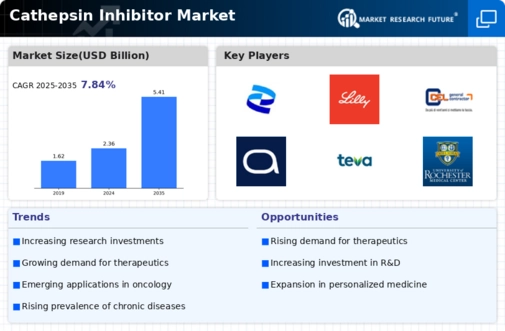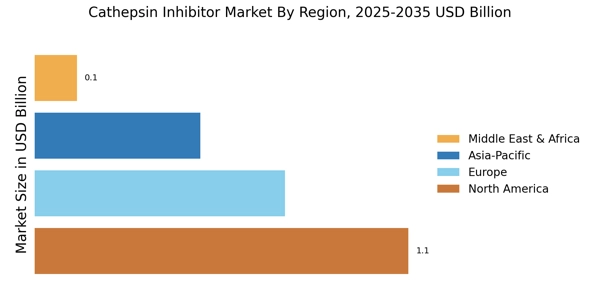Rising Prevalence of Chronic Diseases
The increasing incidence of chronic diseases such as cancer, cardiovascular disorders, and neurodegenerative conditions is a primary driver for the Cathepsin Inhibitor Market. As these diseases often involve cathepsin enzymes in their progression, the demand for effective inhibitors is surging. According to recent data, the prevalence of cancer is projected to rise, with estimates suggesting that by 2030, there will be approximately 21 million new cancer cases annually. This trend necessitates the development of targeted therapies, including cathepsin inhibitors, to improve patient outcomes. Consequently, pharmaceutical companies are investing heavily in research and development to create innovative cathepsin inhibitors, thereby propelling market growth.
Growing Interest in Personalized Medicine
The shift towards personalized medicine is reshaping the Cathepsin Inhibitor Market. As healthcare moves away from a one-size-fits-all approach, there is an increasing focus on tailoring treatments to individual patient profiles. Cathepsin inhibitors, which can be designed to target specific molecular pathways, align well with this trend. The market for personalized medicine is projected to grow significantly, with estimates suggesting it could reach USD 2.5 trillion by 2025. This growth is driven by the demand for more effective and targeted therapies, particularly in oncology and rare diseases. Consequently, pharmaceutical companies are prioritizing the development of cathepsin inhibitors that cater to specific patient needs, thereby enhancing their market potential.
Regulatory Support for Innovative Therapies
Regulatory bodies are increasingly supportive of innovative therapies, which is positively impacting the Cathepsin Inhibitor Market. Initiatives aimed at expediting the approval process for breakthrough therapies are encouraging pharmaceutical companies to invest in cathepsin inhibitors. The introduction of programs such as Fast Track and Breakthrough Therapy Designation by regulatory agencies has streamlined the pathway for new drugs. This regulatory environment fosters innovation and encourages the development of cathepsin inhibitors that address critical health challenges. As a result, the market is poised for growth, with an increasing number of cathepsin inhibitors likely to receive expedited approval, thereby enhancing their availability to patients.
Advancements in Drug Development Technologies
Technological innovations in drug development are significantly influencing the Cathepsin Inhibitor Market. The integration of artificial intelligence and machine learning in drug discovery processes has streamlined the identification of potential cathepsin inhibitors. These technologies enable researchers to analyze vast datasets, predict molecular interactions, and optimize lead compounds more efficiently. As a result, the time and cost associated with bringing new drugs to market are reduced. Reports indicate that The Cathepsin Inhibitor Market is expected to reach USD 2 trillion by 2025, highlighting the potential for cathepsin inhibitors to capture a substantial share of this expanding market. This trend underscores the importance of technological advancements in fostering innovation within the cathepsin inhibitor sector.
Increased Funding for Biopharmaceutical Research
The Cathepsin Inhibitor Market is benefiting from heightened funding for biopharmaceutical research. Governments and private investors are increasingly recognizing the potential of biopharmaceuticals in addressing unmet medical needs. This influx of capital is facilitating the exploration of cathepsin inhibitors as viable therapeutic options. Recent reports indicate that biopharmaceutical investments have surged, with funding levels reaching USD 200 billion in 2025. This financial support is crucial for advancing research initiatives, clinical trials, and the commercialization of cathepsin inhibitors. As a result, the market is likely to experience accelerated growth, driven by the availability of resources to support innovative research and development efforts.


















Leave a Comment